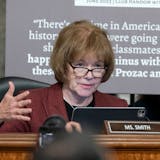One point of agreement in the aftermath of the destruction following the police killing of George Floyd was clear. Businesses needed help to rebuild.
Nearly an entire commercial district along Lake Street was decimated. More damage occurred in other Minneapolis and St. Paul neighborhoods.
Money started pouring in almost as soon as the cleanup of broken glass and brick started. Some came from big corporations, some from community groups, commercial lenders and even crowd sourcing.
What businesses say is missing, however, is dedicated funding from state or federal sources, which could be the biggest source of money for rebuilding efforts.
"It's pretty shocking that a year in, almost no government disaster or any other government assistance related to recovering from civil unrest has arrived or has even been allocated," said Allison Sharkey, executive director of the Lake Street Council.
Legislators visiting Lake Street shortly after the riots damaged more than 1,500 businesses promised help. Nothing has yet materialized.
When Minnesota leaders struck a big-picture budget deal earlier this month for the next two years of state spending, they agreed to include $150 million to help businesses that were "economically devastated in 2020 through no fault of their own," Democratic House Speaker Melissa Hortman said.
However, the details and fate of that assistance remains uncertain as negotiations continue.


